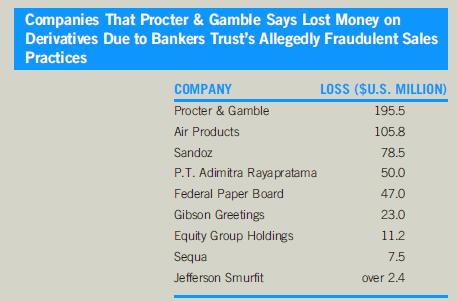Bankers Trust (BT) was one of the most powerful and profitable banks in the world in the
Question:
Bankers Trust (BT) was one of the most powerful and profitable banks in the world in the early 1990s. Under the stewardship of chairman Charles Sanford Jr., it had transformed itself from a staid commercial bank into “a highly-tuned manufacturer of high-margin, creative financial products—the envy of wholesale bankers.”1 BT prided itself on its innovative trading strategies, which used derivatives to manage risks; its performance-driven culture; and its profits: the bank made a profit of over U.S.
\($1\) billion in 1993.2 Key to BT’s success was the dominance of its business in derivatives—contracts in which companies make payments to each other based on some underlying asset, such as a commodity, a financial instrument, or an index.3 The value of the payments—and thus the contract—is derived from those assets. Companies can use derivatives to lower financing costs, manage risk, or speculate on interest and currency rates. It is estimated that almost \($400\) million of BT’s 1993 profits came from its leveraged derivatives business.
Derivatives, with their high margins, held a preeminent position with BT management, with their fervent focus on the bottom line. At BT, each product and each trader was given a value that was based on what income the product or trader could bring the firm.4 The bank’s intense focus on the bottom line decreased attention on products and services that had low margins but that fostered and nurtured client relationships. BT was known for courting customers only insofar as they would buy high-margin products.5 In 1990, Charles Hill, former cohead of merchant banking, left with thirty members of his department because he saw no room at BT for offering clients impartial financial advice and deal structuring. One source within the company explained, “We got rid of the nurturers and builders—the defensive guys—and kept the offensive guys.”6 Those who remained describe a firm driven by intense internal rivalry, endless politicking, and discussions about profit and losses. They describe a “coliseum” mentality at the top level: “we look on while the guys are out there fighting the lions.”7 What remained was a bank where the customer’s interests appeared to come second to the bank’s.
It was within this context that BT, once one of the most powerful banks in the world, was disgraced by a series of highly publicized lawsuits brought forth by several of its clients in 1994 and 1995 over losses they incurred as a result of derivative products sold to them by BT. The clients contended that BT sold them the derivatives without giving them adequate warning and information regarding their potential risks. BT countered that these derivative deals were agreements between the bank and sophisticated clients who were now trying to escape from their loss-making contracts by crying foul.8 At issue was whether the clients were naive and should have known what they were getting into or whether BT deliberately deceived them (p. 110).9 There were more than half a dozen companies that suffered losses as a result of derivatives due to BT’s allegedly fraudulent sales practices (see table below), but the Procter & Gamble (P&G) case is representative of the other cases........

Questions:-
1. What do you think the basis of settlement should have been?
2. Did BT have a duty to disclose all the information it had regarding the transactions to P&G, including pricing, mark to market value, and risk, or should P&G, a multi-billion-dollar company, have ensured that it knew and understood these figures and risks prior to engaging in the transactions?
3. Did BT have an ethical duty to ascertain the suitability of these products for P&G, or did its responsibilities end with providing its client with the product it demanded?
4. Was the maxim of “buyer beware”
more appropriate than “seller beware”?
5. What other ethical issues are raised by the case?
Step by Step Answer:

Business And Professional Ethics
ISBN: 9781337514460
8th Edition
Authors: Leonard J Brooks, Paul Dunn





